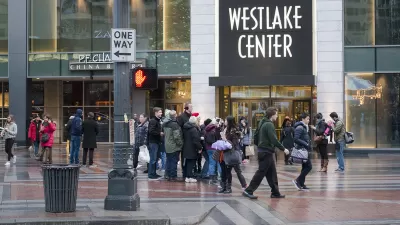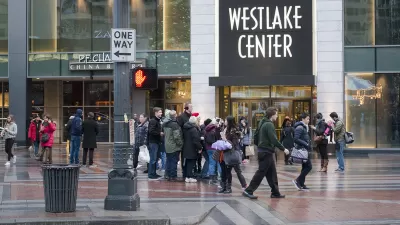With the plan update process for Seattle's Pedestrian Master Plan underway, one writer wonders why the plan is setting firmer goals for increased mode share.

Ryan Packer offers a critique of the Pedestrian Master Plan update currently underway at the Seattle Department of Transportation (SDOT). Noting that the number of commuters walking to work grew by 50 percent between 2010 and 2015, Packer determines that the plan update is disappointingly short on the kinds of goals that can further that progress.
For instance, Packer points out that the Pedestrian Master Plan lacks mention of the city's Vision Zero goal for 2035, and instead, "the goal is laid out as a decreasing rate of pedestrians involved in crashes."
Although Packer acknowledges the good intentions of the plan update, which includes mentions of pedestrian mode share, transit ridership, kids walking to school, and streetscapes, "without concrete goals to tell us just how successful our master plan is, we won’t be able to truly gauge success or failure."
Against this backdrop, Packer contrasts the Move Seattle levy, approved by voters in November 2015. That levy has a dashboard and a number of concrete targets to help residents track the success of that $930 million effort.
Back in August 2016, Packer also critiqued the implementation of the current version of the Pedestrian Master Plan, approved in 2009, focusing mostly on issue of maintenance and operations.
FULL STORY: Seattle’s Pedestrian Master Plan Is Short On Concrete Goals

Alabama: Trump Terminates Settlements for Black Communities Harmed By Raw Sewage
Trump deemed the landmark civil rights agreement “illegal DEI and environmental justice policy.”

Planetizen Federal Action Tracker
A weekly monitor of how Trump’s orders and actions are impacting planners and planning in America.

How Atlanta Built 7,000 Housing Units in 3 Years
The city’s comprehensive, neighborhood-focused housing strategy focuses on identifying properties and land that can be repurposed for housing and encouraging development in underserved neighborhoods.

In Both Crashes and Crime, Public Transportation is Far Safer than Driving
Contrary to popular assumptions, public transportation has far lower crash and crime rates than automobile travel. For safer communities, improve and encourage transit travel.

Report: Zoning Reforms Should Complement Nashville’s Ambitious Transit Plan
Without reform, restrictive zoning codes will limit the impact of the city’s planned transit expansion and could exclude some of the residents who depend on transit the most.

Judge Orders Release of Frozen IRA, IIJA Funding
The decision is a victory for environmental groups who charged that freezing funds for critical infrastructure and disaster response programs caused “real and irreparable harm” to communities.
Urban Design for Planners 1: Software Tools
This six-course series explores essential urban design concepts using open source software and equips planners with the tools they need to participate fully in the urban design process.
Planning for Universal Design
Learn the tools for implementing Universal Design in planning regulations.
Jessamine County Fiscal Court
Caltrans
Institute for Housing and Urban Development Studies (IHS)
City of Grandview
Harvard GSD Executive Education
Toledo-Lucas County Plan Commissions
Salt Lake City
NYU Wagner Graduate School of Public Service




























